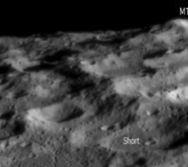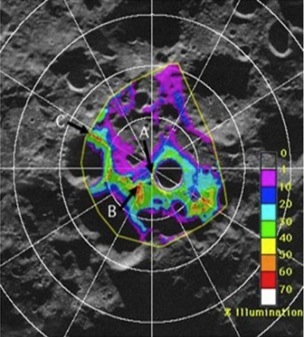


Landing Site:

Location! Location! Location!
High Percentage of Illumniation Providing Solar Energy Resource
Permanently Shadowed Areas for water/voltaic traps
mild temperature range
Clementine and Lunar Prospector Data Suggests the Presence of Water ICe in Shackleton Crater Basin
Advantages of the
Aitken basin
for Exploration

THE LUNAR DAY
The Lunar day/night lasts 27 earth days, 7 hours and 43 minutes. This is exactly the same time it take for one revolution around the Earth keeping one lunar hemisphere (called the near side) facing earth at all times. The rotation is approximately 14.5 earth days for one lunar day and 14.5 earth days for one lunar night. At the poles the sun does not rise very high in the sky at any time.
Studies from the Apollo landings show that the early lunar morning is the optimal landing time because of the ambient lighting conditions. The best being from noon of the 1st earth day until the end of the 2nd earth day. [20] Our rover will land during the early morning of the 2nd earth day of the lunar morning. This offers a good time for the rover to land safely because the terrain is easier to distinguish in the lighting conditions. At other times the terrain is washed out and the computer software has a harder time distinguishing obstacles. The first 5 earth days of the lunar morning and days 9 - 14 the times that lighting conditions are good for travel and exploration. During the lunar afternoon, days 14 -29, the surface is lit by earthshine, except for areas that receive continuous lighting at the south pole. [21]


Moon: South Pole Landing sites P.J. Stooke [24]
Region Map showing rover paths into permanently shaded areas.
TRAVEL PLAN
The robot will travel from the landing site along the rim of the de Gerlache crater. The solar subpower system will be left on the rim to collect solar power. The main robot will be able to travel into the crater to the permanently shadowed areas to take core samples. The robot will travel back to the solar subpower station every four earth days when it is exploring the top of the crater slopes. It can use its own solar panels for power at several places along the rim of the craters where the light is shining most of the time. During the noon period of the lunar day, the robot will have to rest. This time is when the ambient light is not very good for distinguishing objects on the landscape. It lasts for about 2 earth days. The robot will go into hibernation mode during this period. During the lunar day the robot will have time to explore into the de Gerlache crater, near by crater A and possibly to the Shackleton crater. The robot can travel between these craters during the 29 day lunar cycle.
The robot will take samples from many different places to look for water/ice. The more places, the more chance the robot has of finding water/ice. The drill on the robot can get core samples 1 meter down and the scoop on the front can turn up the loose regolith on the surface.
The lunar South Pole offers many things for a rover exploration. The ‘peak of eternal light’ is a ridge between crater rims where the sun shines most of the time. A rover could use solar power cells to store power from here. There isn’t just one area that is in constant sunlight but along the rim there are several spots where the sunlight shines on at least one of them all the time. [19]
Our target is the Aitken Basin at the South Pole, specifically the de Gerlache crater. (*7 on the map below) Our lander will put down near the rim of the crater in between Gerlache and Shackleton. Gerlache is an older crater that has a better chance of having collected volatiles, like water ice, and it has a large area to be explored, over 20 kilometers/12 miles. The larger the area gives a better chance of finding ice water, one of our missions. The crater also has shallower slopes for climbing down into the permanently shaded areas. Newer craters like Shackleton (*1 and *2 on map) have steep walls that might not be safe for exploration. Its young age also means there is probably less volatiles because its had less time to collect them.








